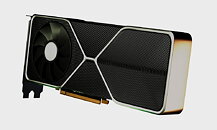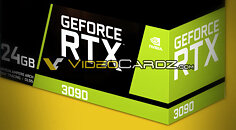Friday, August 28th 2020

NVIDIA GeForce RTX 3090 and 3080 Specifications Leaked
Just ahead of the September launch, specifications of NVIDIA's upcoming RTX Ampere lineup have been leaked by industry sources over at VideoCardz. According to the website, three alleged GeForce SKUs are being launched in September - RTX 3090, RTX 3080, and RTX 3070. The new lineup features major improvements: 2nd generation ray-tracing cores and 3rd generation tensor cores made for AI and ML. When it comes to connectivity and I/O, the new cards use the PCIe 4.0 interface and have support for the latest display outputs like HDMI 2.1 and DisplayPort 1.4a.
The GeForce RTX 3090 comes with 24 GB of GDDR6X memory running on a 384-bit bus at 19.5 Gbps. This gives a memory bandwidth capacity of 936 GB/s. The card features the GA102-300 GPU with 5,248 CUDA cores running at 1695 MHz, and is rated for 350 W TGP (board power). While the Founders Edition cards will use NVIDIA's new 12-pin power connector, non-Founders Edition cards, from board partners like ASUS, MSI and Gigabyte, will be powered by two 8-pin connectors. Next up is specs for the GeForce RTX 3080, a GA102-200 based card that has 4,352 CUDA cores running at 1710 MHz, paired with 10 GB of GDDR6X memory running at 19 Gbps. The memory is connected with a 320-bit bus that achieves 760 GB/s bandwidth. The board is rated at 320 W and the card is designed to be powered by dual 8-pin connectors. And finally, there is the GeForce RTX 3070, which is built around the GA104-300 GPU with a yet unknown number of CUDA cores. We only know that it has the older non-X GDDR6 memory that runs at 16 Gbps speed on a 256-bit bus. The GPUs are supposedly manufactured on TSMC's 7 nm process, possibly the EUV variant.
Source:
VideoCardz
The GeForce RTX 3090 comes with 24 GB of GDDR6X memory running on a 384-bit bus at 19.5 Gbps. This gives a memory bandwidth capacity of 936 GB/s. The card features the GA102-300 GPU with 5,248 CUDA cores running at 1695 MHz, and is rated for 350 W TGP (board power). While the Founders Edition cards will use NVIDIA's new 12-pin power connector, non-Founders Edition cards, from board partners like ASUS, MSI and Gigabyte, will be powered by two 8-pin connectors. Next up is specs for the GeForce RTX 3080, a GA102-200 based card that has 4,352 CUDA cores running at 1710 MHz, paired with 10 GB of GDDR6X memory running at 19 Gbps. The memory is connected with a 320-bit bus that achieves 760 GB/s bandwidth. The board is rated at 320 W and the card is designed to be powered by dual 8-pin connectors. And finally, there is the GeForce RTX 3070, which is built around the GA104-300 GPU with a yet unknown number of CUDA cores. We only know that it has the older non-X GDDR6 memory that runs at 16 Gbps speed on a 256-bit bus. The GPUs are supposedly manufactured on TSMC's 7 nm process, possibly the EUV variant.


216 Comments on NVIDIA GeForce RTX 3090 and 3080 Specifications Leaked
Waiting for reviews and then some before even thinking of 30 series after 20 series space invaders :)
But from the looks of it hydro copper all the way this ugle air cooler I'll never see in person.
I mean how do you compared TGP to the old TDP values. is the 350W TGP gonna be similar to the 250W TDP of the 2080Ti, plus extra for board power? But then can you see the rest of the components using another 100W?
in case the dies are bigger than 429mm2 can't possibly be EUV .
Problem is, we have no idea what AMD is preparing with RDNA2, outside of reasonable guesses based on those console APUs.
GTX 980... 165 W
GTX 1080...180 W
RTX 2080(S)... 215/250 W
RTX 3080... 320W
Price is proberly in between 1000 and 2000$. Nvidia is the new apple.
Given that Sony can push its RDNA chip to 2.1Ghz, if 7nm is true, NV boost frequency must be higher than that.Why on earth would RT cores need to consume anything, unless one of those dozen games that support it is running?
Edit. It says 1710MHz boost for RTX3080
just kinda meh all around...and really 10gb of ram for a 3080? I would atleast have given it 16 or so.
oh welll, guess just like with Intel, this is what you get with no competition in that area, remember the RX5700(XT) is really more around RTX2060s / RTX2070s territory.
And 7nm would be at least surprising at this point, but who knows.